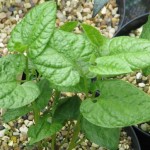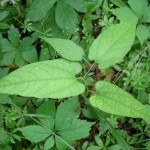Virginia Snake Root – Aristolochia serpentaria
|
Current Demand = Normal |
Parts Used: Rhizome & Root |
 |
 |
 |
Family: Aristolochiaceae
Common Names: Virginia snakeroot, birthwort, Dutchmanspipe, pelican flower, sangrel, sangrel-root, serpentaria, serpentary root, snakeroot, snakeweed, thick birthwort…
Description
Virginian snakeroot is a perennial plant that grows from 1-3 feet in height. The plant is erect with a tem that holds thin alternating leaves that are heart shaped at the base. There are a few light purplish-brown flowers that are often hard to spot.
The flowers, which are hermaphrodite, grow close to the ground, are pollinated by flies, and bloom from May to July. The roots are fibrous, horizontal and short with many thin roots trailing from the main stem. The plant does produce a fruit that is about half an inch, round and contains seeds.
Growing Region: The Virginia snakeroot can be found in the Eastern U.S. from Connecticut to Florida, west to Texas and North to Ohio. An abundance of Virginia snakeroot can be found in Kentucky, Indiana, Tennessee and Ohio. However, the root system is very small and it takes a great deal to make a pound. Therefore, harvest of this plant should be done primarily on land under development, clear cuttings of mining where most all plants will be destroyed anyway. Larger plants can be found to the south in Texas and Arkansas. It can be found in rich dry woods, forest, woodlands, stream banks and shady ravines.
Harvesting/Drying
Parts Used: rhizome, root
For maximum potency Virginia snakeroot should be harvested in the late summer and fall after it has had time to seed. Only the plants roots have medicinal purposes and market value. Gather larger more mature plants leaving plenty of younger plants to seed the area for future harvest. The root is slender and tortuous and is dull yellowish-brown in color. It has a strong taste, bitter and camphoreceous.
After harvesting, wash in cold water after removing all foreign matter (rocks, weeds and other roots) and spread in a thin layer for drying. When possible dry indoors in a well ventilated barn loft or attic to protect it from the elements. If a natural heat is not available, you may need to add heat and a fan for continuous airflow. You will need to turn the roots daily to aid in drying.
The key to drying any root, herb or bark is an even combination of heat and airflow. Never dry in a microwave or oven. Due to the small hair like root system, Virginia snakeroot will be completely dry (largest root will snap not bend) in 3-5 days. Once the root is completely dry, store in a cardboard box or paper sack in a dry area until ready to sell or use. Never store the root in plastic as it may mold.
Cultivation/Planting
The plant prefers light (sandy), medium (loamy) and heavy (clay) soils and requires well-drained soil. The plant prefers acid, neutral and basic (alkaline) soils and can grow in very alkaline soil. It can grow in semi-shade (light woodland) or no shade. It requires dry or moist soil.
Propagation Seed: best sown in a greenhouse as soon as it is ripe in the autumn. Germination usually takes place within 1 – 3 months. Stored seed germinates better if it is given 3 months cold stratification. When large enough to handle, prick the seedlings out into individual pots and grow them on in the greenhouse for their first winter. Plant out in late spring or early summer after the last expected frosts.
Division: the roots can be divided in the fall and planted immediately into a permanent home.
Attributes (Images)
Photo by Adrienne L. Bozic
By peganum from Henfield, England (Aristolochia serpentaria) [CC BY-SA 2.0], via Wikimedia Commons
By uwdigitalcollections [CC BY 2.0], via Wikimedia Commons
 Root Buyer
Root Buyer